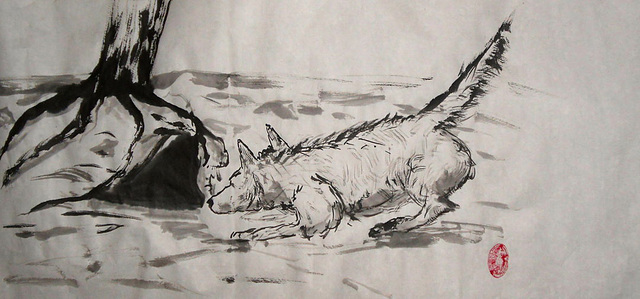Studies
Hell's Obasans
passing season
plum blossoms 2
Santa Claws
De legende van de Witte Wieven
Sister Josephine
Peel me a grape.
Quiet night
How the west was done
Lost in inner space
Cow Satori
Not quite Lassie
downtown
Time
Fear not, you're safe now!
Tuesday morning doodle, pooling their ideas
Wednesday morning doodle, Solitude
Problem solved
Consider the consequences
Rainy day downtown
Signs and Portents
the dance is over
Keeping up with the times
Senrioka
Wonder what happened
Up in the valley
The barrier
Comety of Errors
The boys in the Band
The Owl and the Pussycat went to see
Waiting for Dawn
lunch time
The show
Portrait of the artist as an absinthe drinker
and they danced away the night
12 beats to the bar
There is only one safe crossing point on the river…
fireweed
Days and days
Above the Circle
After Hakuin Ekaku
Snow Nymph!
Contained
See also...
Keywords
Authorizations, license
-
Visible by: Everyone -
All rights reserved
-
184 visits
Curious


While I was painting the 'Returning', I wanted to take a closer look at the wolf, hence this sumi-e. This wolf is younger than the one in 'Returning' , the shortness of his body suggests a juvenile, and he is brim full of curiosity!
The hanko, (the red stamp,in the lower right that I used to sign this work) was carved for me by Oka Isso in Japan, at the request of a good friend of mine. The hanko is a styilized version of the kanji, the word , zoku, written in kanji it's 俗, or written in hiragna it's ぞく.
In her stylized version of 俗 (zoku) Okasan sees the first half of the kanji, 人 (pronounced to, thats a long 'o' not a 'yu' sounds, more like toe), which means person, she sees as a bird rising. The second half, 谷 (tani), meaning valley, she represented by the lines below and to the right and left of the bird.
俗 (zoku): Okasan says that it, in English, means local manners or folkways. Personally there is another meaning for the kanji that I like better: It also means just a common man.
Since the hanko (Oh yea, as I gave the Japanese "spelling" of the other words, I guess I should also include the kanji and hiragana for 'hanko': 判子, はんこ.) is hand carved, each hanko is unique and, subsequently used as a signature.
There is still another meaning of the kanji, 俗 (zoku), that I like best; it can also mean vulgar. However, alas, neither my friend, Tomochan, nor the hanko carver, Okasan, feel that 'vulgar' is a suitable word for me to use as my signature on my sumi-e. :-)
By the way; to see the kanji I included above, you need to have a Japanese font on your computer. If instead of seeing a kanji here, such as 松山市 (which means Matsuyama City) you see something like: æ°´æ>oæ-¥ã??, -that means you do not have the Japanese font installed.
Back to the picture: sumi-e, brushed ink on 'rice' paper, unmounted, 13 by 26 inches.
The hanko, (the red stamp,in the lower right that I used to sign this work) was carved for me by Oka Isso in Japan, at the request of a good friend of mine. The hanko is a styilized version of the kanji, the word , zoku, written in kanji it's 俗, or written in hiragna it's ぞく.
In her stylized version of 俗 (zoku) Okasan sees the first half of the kanji, 人 (pronounced to, thats a long 'o' not a 'yu' sounds, more like toe), which means person, she sees as a bird rising. The second half, 谷 (tani), meaning valley, she represented by the lines below and to the right and left of the bird.
俗 (zoku): Okasan says that it, in English, means local manners or folkways. Personally there is another meaning for the kanji that I like better: It also means just a common man.
Since the hanko (Oh yea, as I gave the Japanese "spelling" of the other words, I guess I should also include the kanji and hiragana for 'hanko': 判子, はんこ.) is hand carved, each hanko is unique and, subsequently used as a signature.
There is still another meaning of the kanji, 俗 (zoku), that I like best; it can also mean vulgar. However, alas, neither my friend, Tomochan, nor the hanko carver, Okasan, feel that 'vulgar' is a suitable word for me to use as my signature on my sumi-e. :-)
By the way; to see the kanji I included above, you need to have a Japanese font on your computer. If instead of seeing a kanji here, such as 松山市 (which means Matsuyama City) you see something like: æ°´æ>oæ-¥ã??, -that means you do not have the Japanese font installed.
Back to the picture: sumi-e, brushed ink on 'rice' paper, unmounted, 13 by 26 inches.
- Keyboard shortcuts:
Jump to top
RSS feed- Latest comments - Subscribe to the comment feeds of this photo
- ipernity © 2007-2025
- Help & Contact
|
Club news
|
About ipernity
|
History |
ipernity Club & Prices |
Guide of good conduct
Donate | Group guidelines | Privacy policy | Terms of use | Statutes | In memoria -
Facebook
Twitter

Sign-in to write a comment.